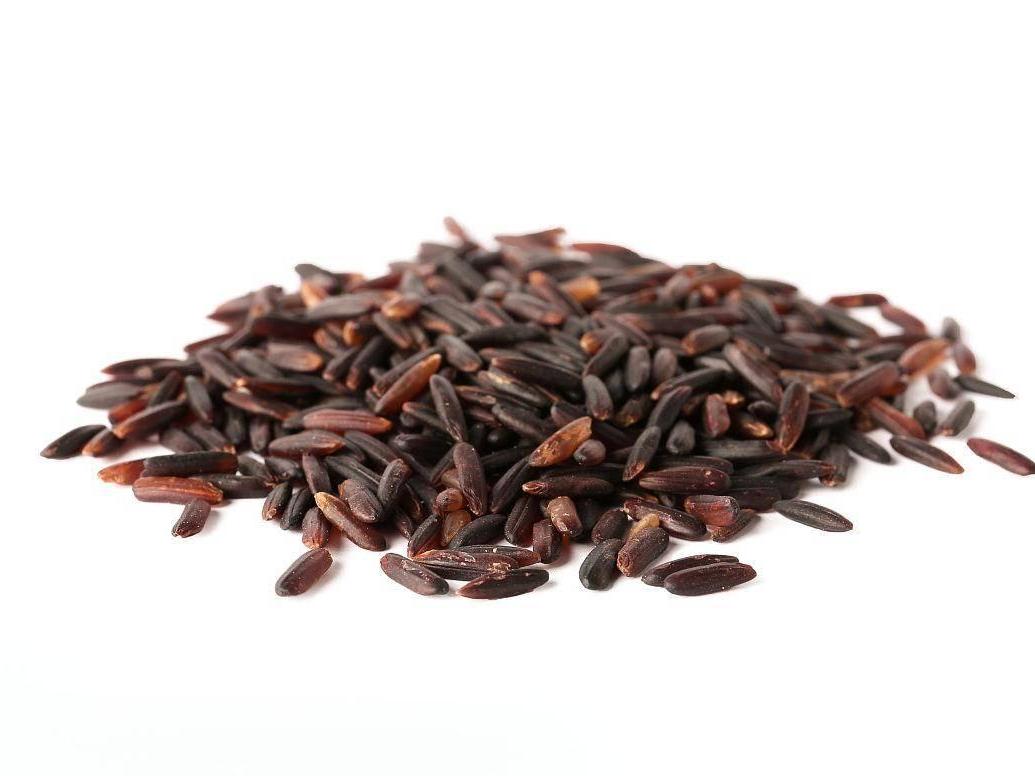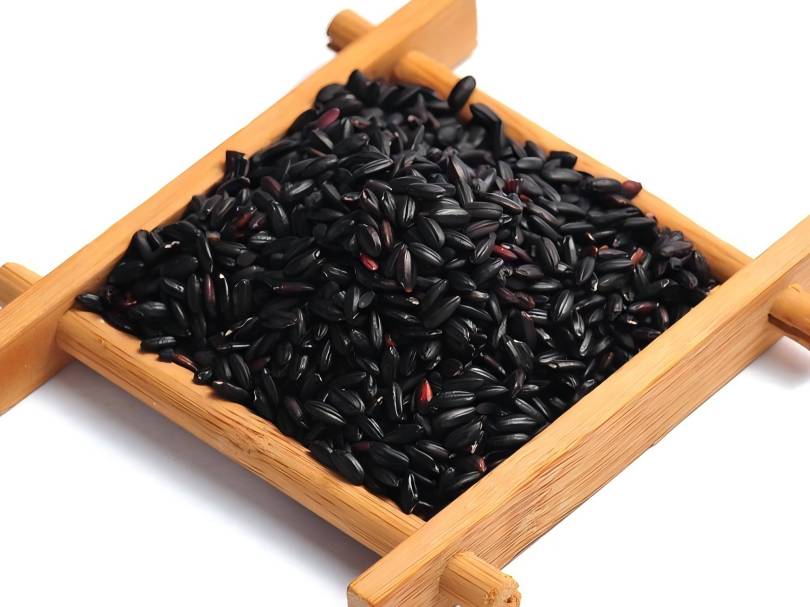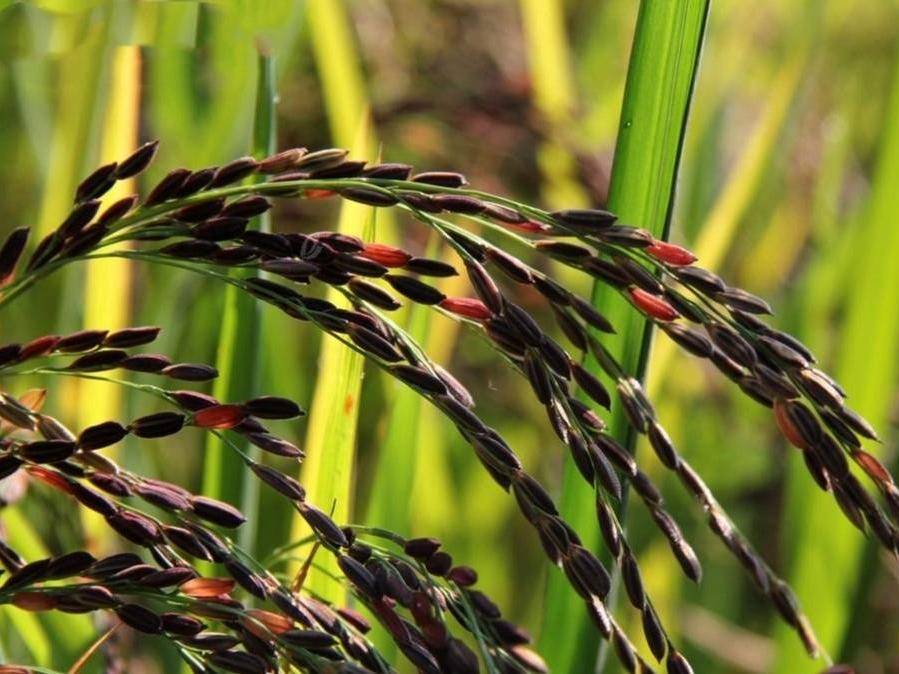What Are the Ingredients in Black Rice Extract?
Black rice is a special type of rice that is rich in nutrients, including various trace elements and anthocyanins. According to the Compendium of Materia Medica, black rice has the effects of nourishing the yin and the kidneys, strengthening the spleen and warming the liver, improving eyesight and promoting blood circulation. In folk culture, black rice has the reputation of being a “precious tribute rice” and “medicine rice” [1]. Modern research has proven that black rice has various biological activities such as anti-oxidation, anti-inflammation, and prevention of cardiovascular and cerebrovascular diseases [2].
These biological functional activities are closely related to the pigment components contained in black rice. Meanwhile, as people pay more attention to their health, black rice, which is often consumed by people, and the pigments in it have also received attention from researchers. At present, there is more and more research on the identification of black rice extract components, extraction process, separation and purification, and stability. Therefore, this paper reviews the research on the composition analysis, extraction and separation and purification process, and stability of black rice pigments, in order to gain a comprehensive understanding of the properties of black rice pigments and promote the development and deep processing of black rice in the fields of food and health food.
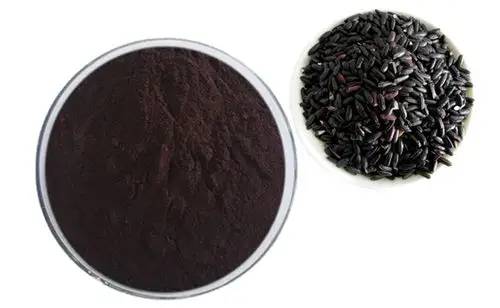
1 Separation, identification and determination methods for the components of black rice extract
1.1 Separation and identification of the components of black rice extract
The main component of black rice extract is anthocyanin. Since anthocyanin is unstable to heat, light and other conditions, it also makes its separation and identification more difficult. At present, the most widely used method for the identification of black rice extract components is liquid chromatography-tandem mass spectrometry.
Sun Wujuan et al. used infrared spectroscopy and high-performance liquid chromatography tandem mass spectrometry to separate and identify the pigment components in the ultrasonic extract of black rice extract. According to the primary and secondary mass spectra of the separated substances, it was determined that the extract contains two anthocyanin components, namely, cyanidin-3-glucoside and peonidin-3-glucoside, with a mass fraction of 15.20% and 39.60%, respectively [3]. Park et al. used black rice extract as the research object and used high performance liquid chromatography and ultraviolet visible spectrophotometry to identify the pigment components of black rice as cyanidin-3-glucoside, anthocyanin-3-glucoside, malvinidin-3-glucoside, geraniol-3-glucoside and delphinidin-3-glucoside, among which the content of centaureidin-3-glucoside was the highest, accounting for 95% by relative content [4].
Mikihlemori et al. used high-performance liquid chromatography-photodiode array detection and electrospray mass spectrometry to identify the pigment components of black rice, and proved that the main components were cyanidin-3-glucoside and cyanidin-3-galactoside, with relative contents of 91.13% and 4.74%, respectively [5]. Zhang Mingwei et al. isolated, purified and identified four anthocyanins from black rice: malvin, pelargonidin 3,5-diglucoside, cyanidin 3-glucoside and cyanidin 3,5-diglucoside. of which geranium -3, 5- diglucoside and cornflower -3, 5- diglucoside are components that have not been identified by previous generations [6].

In summary, the pigment composition of black rice is composed of a variety of anthocyanin components. The component identified by researchers is cornflower -3- glucoside, which is also the component with the highest content.
1.2 Determination method of black rice extract
Currently, the main methods for determining black rice extract include spectrophotometry, high-performance liquid chromatography, and liquid chromatography-mass spectrometry tandem methods. The advantage of the liquid chromatography-mass spectrometry tandem method is in separation and identification, with many advantages such as high efficiency, speed, and sensitivity. However, the equipment used in this method is more expensive, and the technical requirements for operation and maintenance are higher. Liquid chromatography and spectrophotometry are more suitable for ordinary enterprises and other institutions.
Ying Longbin et al. used cyanidin-3-glucoside as the standard substance to establish a method for the detection of anthocyanin substances in black rice by high performance liquid chromatography. The detection wavelength was determined to be 275 nm, and the mobile phase was methanol and water (containing 1% formic acid), which was eluted in a gradient. The method has good linearity (R=0.9998) in the range of anthocyanin mass concentration of 0.0052 to 0.052 mg/mL, with an average recovery rate of 99.72%, RSD of 0.9100, and a minimum detection limit of 0.1 ng/mL [7].
As early as 1982, Osawa used the pH difference method to determine the anthocyanin content in food. Using cyanidin-3-glucoside as the reference substance, he established a method for determining anthocyanin using the fact that the structural transformation of anthocyanin components under different pH conditions is a function of pH, and the absorbance values are different at the same wavelength [8]. Zhou Shukun et al. used this method to determine the pigment content of black rice. Using cyanidin-3-glucoside as the reference substance, they measured the maximum absorbance of black rice extract solutions at pH 1.0 and 4.5, and calculated the pigment concentration of black rice based on the molecular weight and extinction coefficient of cyanidin-3-glucoside [9].
During the extraction and purification processes of black rice extract, researchers prefer simple and rapid measurement methods. Zhang Yinliang, Guo Mei and Wu Suping, among others, used spectrophotometers to determine the extraction rate of black rice pigments. After the sample extract was appropriately diluted, the absorbance was measured at its maximum absorption wavelength, and the absorbance value was used to evaluate the extraction or purification results [10-12].
2 Stability of black rice extract
The stability of anthocyanin components is susceptible to factors such as light, temperature, and oxidants. Anthocyanin is temperature sensitive, and prolonged heating will cause it to form a colorless chalconone structure and fade. Anthocyanin can be converted from the ground state to the excited state by strong light irradiation, making it more prone to degradation reactions [13]. At present, the components of black rice extract have been identified as anthocyanin components. Therefore, researchers have studied the stability of black rice anthocyanin under conditions such as light and heat to clarify the storage and application conditions of black rice pigments.
2.1 The effect of heat and light on the stability of black rice extract
Jiang Xinlong used isolated and purified black rice pigment extract as the object of study, and proved that the thermal and photodegradation of black rice anthocyanin both conformed to the first-order reaction kinetic equation [13]. Ji Yunqi et al. heated black rice pigment solutions to 70 °C and 100 °C, respectively, for 30 minutes, and found that the absorbance at 510 nm decreased by 7.2% and 20%, respectively [14]. This proves that the higher the temperature and the longer the heating time, the faster the thermal degradation of black rice anthocyanin. Black rice anthocyanin was placed under constant temperature conditions of 24°C and a pH of 3.0, and then exposed to natural indoor light (average light intensity 10001x), strong sunlight (average light intensity 450001x), and dark conditions for 10 days. The degradation rates were 0.01184/h, 0.01639/h and 0.0035/h, with half-lives of 58.54, 42.29 and 197.80 h, respectively [13]. It can be seen that black rice pigment is relatively poor in heat and light resistance, and that low temperatures and dark conditions are conducive to its preservation.
2.2 Effect of ultrasonic field on the stability of black rice extract
Zhou Shukun et al. studied the effect of ultrasound on the stability of black rice extract. The effects of initial concentration, pH, ultrasonic frequency, ultrasonic power and reaction temperature on the degradation of black rice pigments were explored. Through reaction kinetic analysis, the chemical reactions of black rice pigments in ultrasonic and non-ultrasonic environments both conformed to the first-order reaction law. In the ultrasonic field, the activation energy was 37697.94 kJ/mol, and the pre-exponential factor was 3800.55 s-1. In a non-ultrasonic environment, the activation energy is 39531.41 kJ/mol, and the pre-factor is 2887.07 s-1. A comparison shows that ultrasound can reduce the activation energy and increase the number of effective molecular collisions, making the degradation reaction more likely to occur. It can be seen that the number of effective molecular collisions of black rice pigment in the ultrasonic field increases, and the activation energy decreases, making the reaction more likely to occur [9].
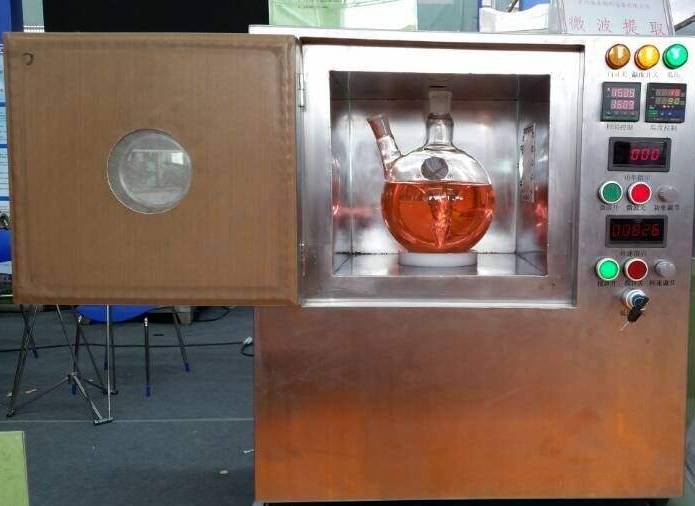
2.3 Effect of acidity and alkalinity on pigment stability
Black rice extract shows different colors in different acid-base solutions, and its stability is also different, which is consistent with the nature of anthocyanins. When the pH of the black rice pigment solution is < 4, the pigment is red; when the pH of the black rice pigment solution is 5 to 7, the black rice pigment is purple. Zeng Huiqin and others have demonstrated that under acidic conditions and at a temperature of 40°C, black rice pigment is stable to vitamin C, low concentrations of preservatives and different metal ions Na1+, Mg2+, Ca2+, and Zn2+. Under alkaline conditions, relatively long periods of high temperatures, oxidants such as H2O2, metal Fe3+ ions, high concentrations of benzoic acid, and ultraviolet light all affect the stability of black rice pigment [15].
2.4 Factors affecting metal ions
Research by Mila and others has shown that metal ions have a selective color-enhancing effect on black rice pigments. When Zn2+ or Mg2+ is present in the solution, the solution is red; when Fe2+ is present, the solution is blackish purple; when Ca2+ is present, the solution is blackish red; and when Al3+ is present, the solution is purple. The color-enhancing effect of metal ions on pigments is related to the hydrolysis of ions and the chelation of pigments and metal ions. The mechanism needs to be further investigated.
3 Extraction and purification technology of black rice extract
3.1 Solvent extraction
Solvent extraction technology is one of the most widely used natural product extraction techniques. This method mainly selects an appropriate extraction solvent based on the chemical properties of the target component in the raw material and the principle of like dissolves like, and avoids the dissolution of non-target components as much as possible. Commonly used extraction methods include maceration, decoction and reflux. The extraction of black rice extract is mostly carried out by maceration, and an ethanol solution of appropriate pH is mostly used as the extraction solvent. Wu Suping et al. used ethanol as the solvent, which is conducive to the extraction of black rice anthocyanin by the maceration method. The optimal extraction conditions were obtained, namely: 50% ethanol, grinding degree 50 mesh, liquid-to-material ratio 1:5, maceration time 30 min, maceration temperature 80°C, and pH 3 [12]. Guo Mei et al. used ethanol as a solvent and applied the extraction method to extract black rice anthocyanin. Through single factor experiments and orthogonal experiments, the main factors affecting the extraction rate of black rice pigments were determined: extraction time > liquid to material ratio > extraction temperature > extraction pH. The optimal extraction process conditions were: 95% ethanol, liquid to material ratio 1:45 (g:mL), extraction pH 3.0, extraction temperature 80°C, extraction time 90 min [11].
3.2 Ultrasonic extraction
Ultrasonic extraction technology uses the “cavitation effect”, mechanical effect and thermal effect of ultrasound to accelerate the diffusion and release of effective components and achieve the extraction of target components. This method has been applied to the extraction of various natural products, such as flavonoids, polyphenols and other effective ingredients. This method has the advantages of low extraction temperature, high efficiency and short time.
Zhang Jixiang et al. used an ultrasound-assisted extraction method to extract anthocyanin from black rice. The optimal process conditions were determined: ethanol concentration 80%, ultrasound time 50 min, liquid-to-material ratio 1:32, ultrasound power 250 W, and the optimal extraction rate was 4.5%. This is nearly three times higher than the extraction rate of the traditional Soxhlet extraction method [17]. Zhang Zhihui et al. used ultrasound to assist in the extraction of anthocyanin from black rice. The optimal conditions were determined using the anthocyanin content, DPPH free radical scavenging rate, and total antioxidant capacity as evaluation indicators: ultrasonic power 280W, extraction time 20min, ethanol concentration 70%, solid-liquid ratio (mg/mL) 1:20, temperature 50℃, under these conditions the anthocyanin extraction rate was 12.56mg/g, DPPH free radical scavenging rate was 54.41%, and TAC was 52.38 u/mL [18].
3.3 Microwave extraction method
Microwave extraction technology uses the energy of microwave radiation to heat the extraction solvent, while causing the target components to diffuse and dissolve from the sample into the solvent. This method has the advantages of uniform heating, good selectivity, solvent conservation, simple operation, good reproducibility, energy conservation and environmental protection. In recent years, microwave extraction technology has been widely used in the extraction of effective components from natural products and has also shown certain advantages.
Ma Ping et al. optimized the microwave-assisted extraction process of black rice extract. Using a two-factor, two-level orthogonal design of experiments, it was shown that the ethanol concentration and liquid-to-material ratio had a significant effect on the extraction rate.
The optimal extraction conditions were determined to be an ethanol concentration of 80%, a liquid-to-material ratio of 1:18 (m:V), a microwave extraction time of 94s, and a black rice anthocyanin yield of 4.97% [19]. Wang Hui studied the microwave-assisted extraction of black rice pigment components using the absorbance value of the black rice anthocyanin extract as the evaluation index. The results showed that within the scope of the experiment, microwave power, liquid-to-material ratio, and ethanol concentration had a strong effect on the absorbance of the black rice anthocyanin extract. The microwave action time had a weak effect on the absorbance of the black rice anthocyanin extract, and the black rice anthocyanin extraction rate was positively correlated with microwave power and liquid-to-material ratio, and negatively correlated with ethanol concentration [20].
3.4 Enzyme hydrolysis
Enzymatic hydrolysis makes use of the properties of enzymes. The right enzyme can be selected to break down plant tissue under relatively mild conditions. Cellulase is often used to extract the active ingredients of natural products because it can break down plant cell walls and promote the dissolution of target components.
Liu Yongji et al. used cellulase to extract anthocyanin from black rice bran, and optimized the extraction process through single factor experiments and response surface methods. The optimized process conditions were: enzyme addition amount of 2.0%, enzymatic hydrolysis temperature of 38.7°C, enzymatic hydrolysis time of 128.8min, material to liquid ratio of 1:10, the extraction time was 40 min, the extraction temperature was 50 °C, the ethanol extraction solution concentration was 80%, and under these conditions, the extraction rate of anthocyanin in black rice bran could reach 21.9 mg/g (theoretical value) [21].
3.5 Research on the purification process of black rice extract
The most researched purification techniques for black rice extract are macroporous resin separation and purification technology and membrane separation technology. Hou Zhaohua compared ADS-5, ADS-7, ADS-F8, ADS-17, NKA-9, AB-8, S-8, D4020 and NKA 9 kinds of macroporous adsorption resin for the purification of black rice pigments. Through the comparison of adsorption and desorption capacity, it was determined that AB-8 macroporous resin is an ideal resin for purifying black rice anthocyanin. The most suitable purification conditions are: elution solvent 80% ethanol, sample loading flow rate 1.0BV/h, desorption flow rate 2.0BV/h. After purification by the resin, the anthocyanin content in the extract is 22.59%, which is higher than the anthocyanin content in the crude extract (3.448%) [22]. Han Hao et al. used membrane separation technology to purify black rice anthocyanin.
First, a ceramic membrane with a molecular weight cut-off of 1000 kD was used to remove the fat-soluble components from the black rice extract, and then a 100D spiral-wound nanofiltration membrane was used to concentrate the degreased extract. Membrane separation and purification of black rice anthocyanin concentrate The dry matter content in the concentrate obtained by membrane separation and purification was 6.46 g/100 mL, and the dry matter content in the concentrate obtained by traditional evaporation technology was 6.56 g/100 mL. The color values were 2.71 and 1.93, respectively, The fat content was 0.30 and 0.28 g/100 mL, respectively. It can be seen that membrane separation and purification technology can improve the purity and quality of black rice anthocyanin. After membrane separation, there is no loss of color value, and at the same time, it has the effect of degreasing and desalination, which proves that membrane separation technology can be used for the purification of black rice anthocyanin [23].
4 Prospects
Black rice is a precious rice in China, and black rice extract is a good natural food additive that can be used as a food ingredient, food coloring, antioxidant, etc., to develop a variety of health-beneficial foods, such as drinks and bread, which are the longest consumed foods by people. Deng Wenhui et al. used black rice extract concentrate as the raw material, combined with sucrose, citric acid, etc., to develop a black rice pigment beverage [24]. However, there is currently little research on the application of black rice anthocyanin extract and purification products, or on the continued use of the residues after pigment extraction. If these two issues can be better addressed, the utilization of black rice extracts and the further processing of black rice will be further developed.
References:
[1] Min Jun. The nutritional characteristics of black rice [J]. Hunan Agriculture. 2013(9): 41.
[2] Yao Shulong. Research on the effect and mechanism of black rice anthocyanin components on cholesterol absorption [D]. East China University of Science and Technology. 2014.
[3] Sun Wujuan, Jin Lingxia, Zhao Caibin, et al. High performance liquid chromatography-tandem mass spectrometry for the composition and structural analysis of black rice pigments [J]. Physical and Chemical Inspection-Chemical Edition. 2012, 48(9): 1023-1026.
[4] Park Y S, Kim S J, Chang H I. Isolation of anthocyanin from black rice (Heugjinjubyeo) and screening of its antioxidant activities [J]. Korean Journal of Microbiology and Biotechnology. 2008, 36(1): 55-60.
[5]Mikihlemori,Eunmikoh,Alysone M. Influence of cooking on anthocyanins in black rice(Oryza sativa L.japonica var.SBR) [J] . Journal of Agricultural and Food Chemistry. 2009 ,57 (5):1908-1914.
[6] Zhang Mingwei, Guo Baojiang, Zhang Ruifen, et al. Separation, purification and structural identification of the antioxidant active ingredients in black rice [J]. Chinese Agricultural Science, 2006, 39(1): 153-160.
[7] Ying Longbin, Yu Sangang, Liu Cuiping, et al. Determination of anthocyanin components in black rice by high performance liquid chromatography [J]. Journal of Hangzhou Normal University (Natural Science Edition), 2012, 11(1): 28-32.
[8] Osawa Y. Anthocyanins as food colors [M]. New York: Academic Press, 1982. 85-85.
[9] Zhou SK, Cao YP, Huang ZH. Study on the stability of black rice pigment in an ultrasonic field [J]. China Food Additives, 2015(3): 71-76.
[10] Zhang Yinliang, Zhou Wenquan, Zheng Jianqiang, et al. Study on the extraction of anthocyanin from black rice with ultrasound and its antioxidant properties [J]. Journal of Zhengzhou University of Light Industry (Natural Science Edition), 2013, 28(1): 16-20.
[11] Guo Mei, Shi Yunxia. Study on the process of extracting black rice pigment by alcohol-soluble method [J]. Food Research and Development, 2015, 36(8): 58-60.
[12] Wu Suping. Study on the extraction and stability of black rice pigment [J]. Chinese Condiments, 2011, 36(12): 106-110.
[13] Jiang Xinlong. Research on the degradation characteristics of black rice anthocyanins [J]. Chinese Journal of Cereals, Oils and Foodstuffs, 2013, 28(4): 27-31.
[14] Ji Y Q, Xu C Y, Zhang S P. Study on the optimization of the extraction process and stability of black rice pigments [J]. Grain Processing, 2012, 37(2): 33-35.
[15] Zeng H Q, Zhang Y M, Jin H. Study on the stability of black rice pigments [J]. Food Research and Development, 2014, 35(19): 17-20.
[16] Mi, L., Xu, H., Li, J., et al. Extraction and stability of black rice anthocyanin. Journal of Inner Mongolia Agricultural University, 2011, 32(2): 263-265.
[17] Zhang, J., Zhao, W., Bai, X., et al. Optimization of ultrasonic-assisted extraction of black pigments from black rice by orthogonal test method. Food Science, 2010, 31(4): 39-41.
[18] Zhang Zhihui, Yu Guoping. Ultrasonic-assisted extraction of antioxidant substances from black rice [J]. Food Industry Science and Technology, 2001(12): 338-342.
[19] Ma Ping, Guo Xijuan, Guo Zengwang. Optimization of microwave-assisted extraction process of melanin from black rice [J]. Food and Machinery, 2014, 30(5): 229-231.
[20] Wang Hui. Research on the influencing factors of microwave-assisted extraction of melanin from black rice [J]. Guangdong Agricultural Science, 2013(7): 92-94.
[21] Liu Yongji, Liu Guoling, Huang Qiandi, et al. Research on the optimization of cellulase-assisted extraction of anthocyanin from black rice by response surface methodology [J]. Food Research and Development, 2014, 35(10): 24-27.
[22] Hou Zhaohua, Zhai Huqu, Wan Jianmin. Extraction and purification of black rice anthocyanins [J]. Food Science. 2010, 31(10): 53-59.
[23] Han Hao, Li Xinsheng, Zhang Zhijian, et al. Application of membrane technology in the degreasing and concentration of black rice anthocyanin pigments [J]. Food Science, 2012, 33(6): 297-300.
[24] Deng Wenhui, Li Xinsheng, Wu Sanqiao, et al. Black rice pigment purification and sports drink formulation research [J]. Food Science and Technology, 2013, 38(6): 109-113.


 English
English French
French Spanish
Spanish Russian
Russian Korean
Korean Japanese
Japanese